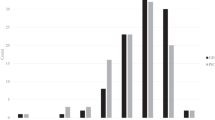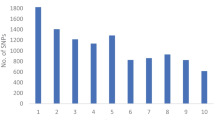Abstract
We analyzed polymorphism in the parental lines GK26 and Mo17 and testers Od221MV, Od308MV, and Od329 using SSR-analysis. Recombinant inbred lines (RILs) from populations F4 and F6 were genotyped at ten polymorphic loci. Allelic compositions and allele frequencies at microsatellite loci were investigated in parental lines and testers, and the best highly heterotic hybrids and their molecular genetic formulae were derived. The allelic composition of microsatellites were investigated in RILs and high-yield hybrids for the best combining ability parameters.
Similar content being viewed by others
References
Charcosset, A. and Moreau, L., Use of molecular markers for the development of new cultivars and the evaluation of genetic diversity, Euphytica, 2004, vol. 137, pp. 81–94.
Guimaraes, E.P., Ruane, J., Schert, B.D., et al., Marker-Assisted Selection. Current Status and Future Perspectives in Crops, Livestock, Forestry and Fish, Rome: FAO, 2007.
Sivolap, Yu.M., Kozhukhova, N.E., and Kalendar’, R.N., Variabel’nost’ i spetsifichnost’ genomov sel’skokhozyaistvennykh rastenii (Variability and Specificity of Crop Genomes), Odessa: Astroprint, 2011.
Ajmone, Marsan, P., Gorni, C., Chitt, A., et al., Identification of QTLs for grain yield and grain related traits of maize (Zea mays L.) using an AFLP map, different testers, and cofactor analysis, Theor. Appl. Genet., 2001, vol. 102, pp. 230–243.
Barbosa, A.M., Geraldi, I.O., Benchimol, L.L., et al., Relationship of intra- and interpopulation tropical maize single cross hybrid performance and genetic distances computed from AFLP and SSR markers, Euphytica, 2003, vol. 130, pp. 87–99.
Moreau, L., Charcosset, A., and Gallais, A., Experimental evaluation of several cycles of marker-assisted selection in maize, Euphytica, 2004, vol. 137, pp. 111–118.
Blanc, G., Charcosset, A., Mangin, B., et al., Connected populations for detecting quantitative trait loci and testing for epistasis: and application in maize, Theor. Appl. Genet., 2006, vol. 113, pp. 206–224.
Schrag, T.A., Mohring, J., Maurer, H.P., et al., Molecular marker-based prediction of hybrid performance in maize using unbalanced data from multiple experiments with factorial crosses, Theor. Appl. Genet., 2009, vol. 118, pp. 741–751.
Bernardo, R., Molecular markers and selection for complex traits in plants: learning from the last 20 years, Crop Sci., 2008, vol. 48, pp. 1649–1664.
Ragot, M. and Lee, M., Marker-Assisted Selection in Maize: Current Status, Potential, Limitations and Perspectives from the Private and Public Sectors, Rome: FAO, 2007.
Yousef, G.G. and Juvik, J.A., Comparison of phenotypic and marker-assisted selection for quantitative traits in sweet corn, Crop Sci., 2001, vol. 41, pp. 645–655.
Blousov, A.O., Sivolap, Yu.M., Sokolov, V.M., and Domenyuk, V.P., UA Patent 86180, 2009.
Domenyuk, V.P., Blousov, A.O., and Sivolap, Yu.M., Selection for DNA markers of quantitative trait loci in maize breeding, Visn. Kharkiv. Nats. Agrar. Univ., 2003, no. 3 (2), pp. 87–91.
Sivolap, Yu.M., Sokolov, V.M., Belousov, A.O., and Domenyuk, V.P., Genetic improvement of maize populations by selection for DNA markers of quantitative trait loci: Guidelines, Odessa, 2003.
Zenishcheva, L.S., Heritability of quantitative traits that determine plant resistance to lodging, S.-Kh. Biol., 1968, no. 3, pp. 790–794.
Dremlyuk, G.K. and Gerasimenko, V.F., Priemy analiza kombinatsionnoi sposobnosti i EVM-programmy dlya neregulyarnykh skreshchivanii (Techniques for Analysis of Combining Ability and Computer Programs for Irregular Crossings), Moscow: Agropromizdat, 1992.
Dospekhov, B.A., Metodika polevogo opyta (Field Experiment Techniques), Moscow: Kolos, 1973.
Ispol’zovanie PTsR-analiza v genetiko-selektsionnykh issledovaniyakh: Nauch.-Metod. Rukovodstvo (The Use of PCR Analysis in Genetic and Breeding Research: Scientific-Methodological Guide), Sivolap, Yu.M., Ed., Kiev: Agrar. Nauka, 1998.
Burmeister, M., di Sibio, G., Cox, D.R., and Myers, R.M., Identification of polymorphism by genomic denaturing-gradient-gel electrophoresis: application to the proximal region of human chromosome21, Nucleic Acids Res., 1991, vol. 19, pp. 1475–1481.
Maniatis, T., Fritsch, E. F., and Sambrook, J., Molecular Cloning, New York: Cold Spring Harbor Lab. Press, 1982.
Author information
Authors and Affiliations
Corresponding author
Additional information
Original Ukrainian Text © N.I. Bukreyeva, A.A. Belousov, Yu.M. Sivolap, 2014, published in Tsitologiya i Genetika, 2014, Vol. 48, No. 2, pp. 12–19.
About this article
Cite this article
Bukreyeva, N.I., Belousov, A.A. & Sivolap, Y.M. Allelic compositions at polymorphic gene loci in maize inbred and hybrid lines and their associations with levels of heterosis. Cytol. Genet. 48, 76–84 (2014). https://doi.org/10.3103/S0095452714020029
Received:
Published:
Issue Date:
DOI: https://doi.org/10.3103/S0095452714020029




